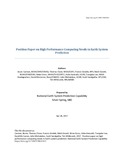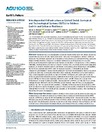Position paper on high performance computing needs in earth system prediction

Download
Author
Carman, Jessie
Clune, Thomas
Giraldo, Francis
Govett, Mark
Gross, Brian
Kamrath, Anke
Lee, Tsengdar
McCarren, David
Michalakes, John
Sandgathe, Scott
Whitcomb, Tim
Date
2017Metadata
Show full item recordAbstract
The United States experiences some of the most severe weather on Earth. Extreme weather or climate
events - such as hurricanes, tornadoes, flooding, drought, and heat waves - can devastate communities
and businesses, cause loss of life and property, and impact valuable infrastructure and natural resources. The number and severity of extreme weather and climate events in the U.S. has risen
since 1980, and is projected to continue rising this century. Growing populations in vulnerable areas create increased risks. If current trends continue, damages from extreme weather and climate events could grow four-fold by 2050.
Predictions and projections of weather and extreme events across time scales from weather to
climate rely on sophisticated numerical models running on High Performance Computing (HPC) systems,
which press the frontier of the Nation’s HPC capability. The Nation’s Earth system modeling community has a unique set of HPC requirements which differ from industry needs. Typically, HPC advances are measured using computational peak performance metrics that are ill-suited to Earth system modeling applications. We advocate for a shift in processor design to increase emphasis on memory bandwidth, so Earth system models run more efficiently and better serve the public need.
Description
The article of record as published may be found at http://dx.doi.org/10.7289/V5862DH3
Rights
This publication is a work of the U.S. Government as defined in Title 17, United States Code, Section 101. Copyright protection is not available for this work in the United States.Collections
Related items
Showing items related by title, author, creator and subject.
-
WILDFIRE-FAVORABLE OFFSHORE WIND EVENTS IN CALIFORNIA: GLOBAL-SCALE CLIMATE TELECONNECTIONS TO EXTREME WEATHER AND POTENTIAL SUBSEASONAL TO SEASONAL PREDICTABILITY
Jones, Kellen T. (Monterey, CA; Naval Postgraduate School, 2021-06);Wildfire-favorable offshore wind events (OWEs) in California, such as Santa Ana (SA) and Diablo wind events, are extreme weather events that can contribute to severe societal impacts. We analyzed the large-scale weather ... -
UNDERSTANDING THE DRIVERS OF EXTREME PRECIPITATION EVENTS IN PAKISTAN
Ilyas, Hassan (Monterey, CA; Naval Postgraduate School, 2023-12);Pakistan has been highly affected by the impacts of climate change, which have resulted in abnormal weather events. Over the past 14 years, Pakistan has witnessed two large-scale floodings (in 2010 and 2022) caused by ... -
Interdependent Infrastructure as Linked Social, Ecological, and Technological Systems (SETSs) to Address Lock-in and Enhance Resilience
Markolf, Samuel A.; Chester, Mikhail V.; Eisenberg, Daniel A.; Iwaniec, David M.; Davidson, Cliff I.; Zimmerman, Rae; Miller, Thaddeus R.; Ruddell, Benjamin L.; Chang, Heejun (2018);Traditional infrastructure adaptation to extreme weather events (and now climate change) has typically been techno-centric and heavily grounded in robustness—the capacity to prevent or minimize disruptions via a risk-based ...


 Article (182.0Kb)
Article (182.0Kb)

